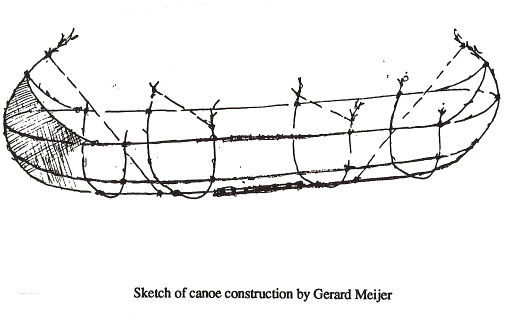Paper Boats in Holland
from Gerard Meijer, of Maarssen, Holland

About 33 years ago, at the age of 16, a friend of mine and I had an idea to build a canoe. But we had no money or materials. We knew that Indians made canoes from materials that nature offers, like twigs and birch bark. Willow spars seemed like the best for their strength and flexibility and are easy to come by in Holland. Here they're still used to make baskets and they are essential in dike building. The keel was made by tying two spars together bent like a bow which resulted in a keel, a stem, and a stern. Then ribs were made by bending small spars and tying them to the keel. The framework was completed by attaching stringers and gunwales, the latter made from thicker spars. All the branches were tied together with rope; not a single nail was used. The frame now looked like a Canadian canoe.
The large birch tree that the Indians used the bark of, does not grow in Holland. Considering our budget we looked for discarded materials that would be useful. We found chicken wire and old newspapers. There was just enough money for a can of coal-tar and with these materials we managed to complete the boat.
The chicken wire was bent and tied to the frame. Paper was tarred and put on the wire. The process was repeated until the hull was strong enough for our liking. We completed the boat by making a floor out of branches to protect the bottom. Would she float? Would she be watertight? Would she be able to cross the Rhine with two of us plus luggage?
Early the next Saturday we took the canoe to the harbor of Wagningen and launched her. It was a sober launch for even if we had a bottle of champagne we were afraid of the damage it might do. It was unbelievable! It really floated and not a leak in it! We loaded our luggage, tent, and sleeping bags and looked again for leaks, but none existed. For security we placed the tar and a heap of newspaper in the center of the boat ready for use.
We paddled out of the harbor and onto the Rhine, staying near the banks for about three miles and then crossing the river. Whenever a big ship passed, our canoe dropped her nose into the waves, but rose without problems. You could feel that the structure of the boat was flexible and seeing it bend, I looked in the bottom for water, but she did not leak. We arrived at a small canal connecting to the Rhine feeling very satisfied with our canoe.
At the end of the canal there was a windmill that regulated the water level. We had to take the boat out of the water to pass the mill. (Behind the mill the river Linge flowed.) We inspected the boat before putting her back in the water. Not a piece of paper was missing. We continued on through the peaceful landscape of Betuwe. By sunset we asked a farmer if we could camp on his property. We took the boat out of the water an placed it upside down for shelter.
The next morning it looked like it was going to rain. We launched the canoe and paddled off Two boys in rain gear in a paper canoe! The rain began! The bean can from the last night's meal was used to bail. The rain came down harder and the bailing intensified. Floating in the water that was thrown out were small pieces of paper. It kept on raining and by the afternoon a lot of the paper was gone. We decided to take the canoe out of the water and hauled out on a slippery and muddy bank.
Our gear was wet and dirty. In the distance there was a bus stop. When the next bus appeared, we were on it. Through the wet and slight foggy windows of the moving bus we caught our last glimpse of our paper boat. We were sure that those who found the boat would wonder what amazing adventures such a peculiar craft might have had.